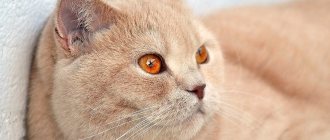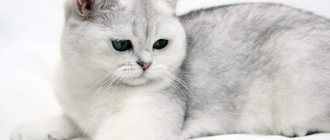| Country of origin | Siam (modern Thailand) |
| Weight | 4-8 kg |
| Wool | short |
| Lifespan | 14-15 years old |
| Other names | Old Siamese, classic, traditional, apple head. |
The favorite of kings, the Thai cat has one of the most ancient histories. For her loyalty and protection of her masters from evil spirits, she received sky-colored eyes as a reward. And this is not just one legend about the Thais. There are more than five of them about the origin of the breed alone.
Origin story
The history of Thai cats is mysterious. This is both a very ancient and at the same time new breed. It is known that a description of a cat with a light body, black ears and tail was found in the “Book of Poems about Cats” (14-15 centuries). Its name was Wichien Maet. Cats lived only in Buddhist temples and the palace of the ruler, for which they received the name “royal”. They had a special purpose - to drive away evil spirits and accompany people to another world in order to protect their souls. When the owner died, the cat was placed alive with him in the tomb. The secret is that the grave had many passages, and the animal could get out of there. When the cat returned after the funeral, it meant that the soul of the deceased had settled in it. The animal was given reverence. Due to their sacred role, the export of cats from the country was prohibited.
There is a version that the original color of Thai cats was dark and their eyes were yellow. During the mixing, the well-known color point, which belongs to the temperature-dependent group, and blue eyes appeared.
Until now, those who are far from breeding work confuse the Thai and Siamese breeds. These are 2 varieties with one ancestor - the Siamese cat, which came to Europe in the late 19th and early 20th centuries from Siam, as Thailand was previously called - the homeland of Thai cats.
The fact is that the cats brought from Siam were of different types. And everyone who was involved in breeding enhanced the traits of a certain species. In the 50s 20th century The Americans emphasized lightness of the skeleton, lengthening of the limbs, and the formation of a wedge-shaped head. The result was the modern Siamese breed. European felinologists adopted the American standard as a basis. And true Thai cats, which were not so graceful, thin and light, did not have a chance.
In Russia there were many lovers of cats with round, slightly heavy shapes and blue eyes. A surge of interest in the old type of Siamese cats occurred in the 70s. 20th century Although it is believed that animals appeared in Russia earlier - in the 90s. 19th century Nicholas II was given a gift from the Emperor of Thailand - 200 purebred individuals.
In the USSR, it was the Old Siamese breed that was bred - strong, muscular. At the end of the 80s of the 20th century. An exhibition organized by WCF took place in Moscow. Based on the results, in 1990 the Thai cat breed was approved and a standard was published.
Legends of appearance
There are 3 common legends about how Thai cats appeared in Europe:
- In 1870, Owen Gould, an official at the British Embassy in Bangkok, brought 2 cats from Siam. It was a gift from the emperor. Eastern beauties have conquered England; they have never been seen here before. The Thais enjoyed a stunning success at the exhibition at the Crystal Palace.
- According to the second version, the animals were brought to England by Anna Crawford, who served as governess to the children of the King of Siam. This happened in 1867.
- In 1871, the king sent 11 Siamese cats to England as gifts to high-ranking officials. It is believed that the history of the new breed began with them.
Description and standard
The Thai breed has medium compact size and well-developed muscles. At the same time it looks graceful and elegant.
The table provides a description of the breed:
| Become | Characteristic |
| Head | Has no sharp corners, rounded. The cheeks are well defined. The muzzle is marked with clearly smooth outlines. The chin is wedge-shaped. |
| The eyes are almond-shaped, large, slightly slanted. The color is blue, blue, the richer the better. It cannot be green or yellow. | |
| The ears have rounded tips and a wide base, located on the sides of the head. | |
| Body | Medium length, muscular, strong bones. The body is flexible, for which Thais are compared in grace to panthers. |
| Legs | Muscular, set in proportion. The paws are round and small. |
| Tail | Thick at the base and tapering towards the tip. The length is average. |
| Wool | The undercoat is insignificant. The hairs are short, silky, and fit tightly to the body. |
| Colors | Thermodependent (acromelanic). Preference is given to light fawn. The body should be colored evenly and contrast with the markings. Tail, paws, ears, muzzle are the same color. |
Appearance
The standard approved in 1991 is currently under revision, so the breed is considered open. This means that any animal similar in phenotype to a Thai cat can be classified as a representative. To confirm such affiliation, it is necessary to have two expert signatures in the registration documents. Such animals are allowed for official breeding.
Head
Round, without pronounced angularities and flat fragments. The forehead is moderately convex, the transition to the nose is clearly marked and is level with the eyes, in no case below the conventional horizontal line running along the level of the lower eyelid. Stop is not observed. The muzzle is clearly marked, the cheeks are round, clearly defined in adult animals. Excessive plumpness is considered a fault. The nose is of medium length, straight.
Eyes
Thai cats have beautiful, large, almond-shaped eyes. Since childhood, they have been slightly slanted; the shade can vary from soft blue to dark blue. At the same time, a more saturated, deep eye color is valued much higher, and an animal’s eyes that are too round or too slanted exclude it from the breed standards.
Ears
They are medium in size, wide at the base and slightly rounded towards the tips. Located widely spaced from each other.
Neck
The length is closer to short. It is preferable for a cat to have a short neck.
Muzzle of a Thai cat
Torso
The body of the Thai cat is dense, muscular, but not massive. The chest is quite wide.
Legs and paws
The limbs are of medium length, proportional to the size of the body. Strong, muscular. The paws are round and small.
Tail
It is slightly wide at the base, but becomes sharper and narrower towards the tip. The length is proportional to the size of the animal's body.
Wool
Thai kittens belong to the short-haired category of pets. Their coat is soft and silky. Animals have no undercoat.
Colors
A distinctive feature of the breed is its color-point color. This means that the cat’s paws, tail, muzzle and ears are necessarily painted in a color contrasting with the rest of the body. The color of the main coat should be light - from cream to snow-white. The standard allows 10 color variations:
- Blue Point. The blue color of the markings combines with the cool shade of the body;
- Seal Point. The most common color. Points are dark brown, almost black;
- Cream point. A cat with creamy markings reminiscent of baked milk;
- Red point. Thai cats with markings the color of boiled condensed milk, the body is snow-white;
- Chocolate point. Pronounced dark chocolate markings, the base color is often darkened;
- Torty point. Exotic spotted color of three colors: red, black and white;
- Tabby point. The muzzle, paws and tail are painted with cute stripes. One of the rarest colors;
- Lilac Point. Light gray-blue spots with a milky color to the rest of the body.
The rarest colors - caramel point (light red with white) and fawn point (light gray with a bluish tint to the coat) are especially valuable.
Thai cat: colors
The real pride of Thai cats is their coloring. The dark, even black color of the paws, muzzle, ears and tail contrasts well with the light body. This color is called differently: “Siamese”, “pointed”, “acromelanistic”, “Himalayan”.
The color is unusual in that it blooms. The coat color of a newborn kitten is completely white. After a couple of weeks, the first marks begin to appear. The edges of the ears become dark, then the muzzle, tail and paws. The color is fully formed within a year. However, the process does not stop. With age, a Thai becomes increasingly darker and “blooms.” It is believed that this can be influenced by nutrition (consumption of buckwheat, liver, some dry food), sterilization, and temperature conditions. But the main factor is genetic.
Initially, Siamese had only 4 point colors:
- Sil – cream body, dark brown markings. The most popular color among cat owners.
- Blue - the body is white-blue, the protruding areas are gray-blue.
- Chocolate – milky chocolate markings on ivory.
- Lilac Point – white body with a slight tinge of ivory and brown-pink points.
After crossing with other breeds, the colors of Thai cats were updated. The following have been added:
- Red or red point - red color of markings.
- Cream – creamy, red colored points.
- Striped (tabby / tabby point or tabby point) or lynx point - stripes are clearly visible on the markings. Such cats always have a pattern in the form of the letter “M” on their heads.
- Tortoiseshell (tortie) – markings are red and cream. Only females can have this color.
It is believed that colorful Thai cats (torti) bring happiness to the house.
The rarest are tortoiseshell and red colors.
Thai cats: character
If there is a leapfrog in the house, there is a whirlwind of things, then the reason here is simple - the blue-eyed Thai cat.
The Thai is considered one of the smartest breeds in the world. Has a high learning ability. Bringing abandoned things is a common activity for them. They can learn to go to the toilet in the toilet. They get used to walking on a leash. They often belong to troupes of circus performers.
At the same time, due to its intelligence, the Thai cat can show leadership qualities and occupy the main position, demonstrating stubbornness.
The breed is agile, active and sociable. Thai cats get used to people, and not to their place of residence. Thais choose their own master and cannot be convinced.
They can be affectionate and restless at the same time. They are constantly on the move and doing things. A quiet life is not for them. All games for both kittens and adults are energetic. It is necessary to create a condition for the energy to splash out in a peaceful way: Thais love to run and are fond of mouse toys and balls. They retain their activity throughout their lives, as well as the desire to play.
Curiosity is an integral feature of Thai cats and a character trait. They are also distinguished by their lack of fear. The combination of curiosity and fearlessness is a leading cause of injury.
Thais know how to “talk”. In addition to “meow,” they have many sounds with different intonations in their arsenal. With their voice they can express joy, request, invitation, love. At the same time, all emotions are reflected on the face.
Who are they suitable for?
The breed will be an excellent choice for both single people and large families with children. The main thing is that the cat is given enough attention - without it he will be bored and mischievous. For such pets, the presence of other cats in the house will not be a disadvantage.
Thai cats are not suitable for workaholics and busy people who are often not at home. Communication with their beloved owner is very important for these pets. It will be especially bad for your cat if you are often sent on business trips.
Do not take such a cat if there are already birds or rodents living at home - the cat will view them as prey, and the acquaintance may end in tragedy. Also, Thai cats are not recommended for allergy sufferers: it is better to look for a hairless cat. It is possible that you will get used to your pet, but no one can guarantee this.
Care and maintenance
Keeping Thais is not much different from other cat breeds with a short coat.
Grooming the coat is not difficult. It is enough to periodically remove fallen hairs with a rubber brush or a hand dipped in water. Despite the short fur there will still be a lot of it.
You need to take care of your oral cavity to avoid plaque and tartar. From childhood, a kitten is taught to brush its teeth. The procedure is unpleasant and resistance is guaranteed. Therefore, you can buy special toys for your pet to remove plaque.
Claws are trimmed once every 2 weeks or as needed.
Thais are active. You need to remember this: close the balcony, install bars and limiters on the windows.
What to feed a Thai cat
For Thais to live a long life, they need to take a responsible approach to feeding.
| Authorized Products | Prohibited Products |
| Beef, poultry (chicken, turkey), rabbit. It is better to choose sinewy pieces and cut into strips. The cat must chew and develop its jaw. The meat is scalded or frozen. | Fatty meat (pork, lamb, duck). Sausages. |
| Heart, lungs, chicken stomachs. | Liver is excluded from the diet for its coloring properties. |
| Sea fish, squid - no more than 2 times a month and boiled. | Seafood and food based on it. The coat darkens from such a diet, and excessive consumption of fish increases the risk of developing urolithiasis. |
| Rice as an additive to meat. | Buckwheat (affects the color of the coat), rolled oats, beans, potatoes. |
| Cottage cheese, fermented milk products. For kittens up to 6 months of age cream. Quail eggs. Chicken yolk. | Milk is not recommended for adult cats. |
| Any vegetables and fruits that your pet likes. | Coloring vegetables (beets, carrots), as well as seaweed and food containing them. |
| Olive, linseed oil 1 tsp. in Week. You can fat, which is formed near the kidneys and liver. | Fish and chicken bones. |
| Vitamins | Fatty, salty, smoked foods. Salo. |
| Super-premium dry food, canned food. | Chocolate, salt, spices. |
Poor nutrition, sudden changes in diet, and cheap food increase the risk of pancreatitis and gastritis.
A nursing cat's food needs to be higher in calories in order to produce enough milk for the development of the babies. Kittens grow quickly.
Kitten weight by month:
| Age | Weight (in g) |
| Newborn | 117 |
| 1-1.5 weeks | 235 |
| 1 month 1 Week | 450 |
| 2.5 months | 900 |
Health
Thai cats have strong immunity. Representatives of the breed may exhibit defects such as squint, crease (not correction) of the tip of the tail. But flaws in appearance do not affect health at all.
However, there are a number of diseases that are most common in Thai and Siamese cats:
- bowel cancer;
- baldness;
- dysfunction of the esophagus;
- asthma;
- heart defect (congenital);
- increased pain sensitivity;
- glaucoma;
- breast cancer.
Thais are temperamental in matters of love. When a cat is in heat, she behaves inappropriately and screams loudly. And high hormonal levels are the cause of cancer of the uterus, mammary glands, and inflammation of the ovaries. Sterilization is considered the best disease prevention. Castration reduces the risk of developing urolithiasis.
Vaccinations
Most pets lead a domestic lifestyle, but they also need vaccinations.
Rules:
- 8-12 weeks – first vaccination. A month later, revaccination. Then they are vaccinated every year.
- If the mother cat has been vaccinated, then the kitten is vaccinated at 12 weeks; if not, at 8.
- 10 days before vaccination, the animal is dewormed.
In practice, doctors use complex vaccines against several diseases at once. These are the drugs Novibak, Quadrikat, Multifel, Felovax.
How long do Thai cats live at home?
Thai cats are long-lived. On average they live 14-15 years. However, it is not uncommon for them to live up to 20 or even 28 years. This largely depends on the conditions created, what to feed the pet, and genetic factors.
How many years do they live?
Thai cats are cats that live a long life - on average, its duration is 17 years. Of course, the natural longevity of this breed must be supported by comfortable living conditions and good nutrition. To ensure that these active minxes do not get injured during the games that they love to indulge in so much, you need to follow some safety rules:
- secure shelves and other heavy interior elements well so that they do not fall on your purr;
- place anti-cat nets on the windows;
- keep cutting objects, needles, fragile dishes, and threads in which she can become entangled, away from your curious pet;
- hide things from your cat that she might ingest: bags, toxic detergents, medications and dangerous plants such as ivy;
- It is recommended to walk your dog on a leash.
How to choose a kitten
The best time to take a kitten home is at least 2 months old. Exhibition animals are sold after 5-6 months, when the teeth have completely changed. And the best age when you can evaluate the baby’s exterior and exhibition future is 4 months.
The main criteria for choosing a kitten are simple: it must be healthy, be able to go to the toilet on its own, and preferably use a scratching post.
Gender doesn't matter. An uncastrated cat will mark where he likes, and an unsterilized cat will meow loudly and demand love. And such characteristics of the breed as cunning, cunning, and stubbornness are characteristic of both boys and girls. The only cats are more affectionate and careful than cats.
Each Thai breeder has his own price for a kitten. The determining factor of how much a purebred Thai kitten costs is class. For show class pets the highest price is from 25 thousand rubles, breed class – 10 thousand rubles, pet class can be purchased from 5 thousand rubles.
Upbringing
By the time they move to a new home, Thai kittens have already mastered the basic rules of behavior well and know how to use a scratching post and litter box. To make the process of getting used to a new place of residence quick and painless, try to create an environment for your baby that is similar to the one in which he spent the first months of his life.
Talk to your pet calmly, without raising your voice unnecessarily. A Thai will quickly understand that if they are dissatisfied with him and loudly scold him, then he has really done something wrong. Keep the use of harsh measures to a minimum. Aggression can only breed aggression. You can calm an overly angry cat with a stream of cool water. This is not painful or humiliating for the royal cat, unlike physical punishment.
Provide your baby with enough toys. This will distract him from mischief and protect your things from damage. Keep valuable items and papers out of reach of the animal.
Having a cat in the house is both a great joy and a huge responsibility. And this responsibility lies with the individual.
How to name a kitten
The character of Thai cats and the history of the breed provide the owner with many options for choosing a name for his pet.
You can choose from Thai names that are pronounced with the emphasis on the last syllable:
| Nickname for a boy kitten | Nickname for a girl's kitten |
| Aron, Vaen, Det, Kosum, Kitty Krysi, Chris, Mai, Manoj, Nai, Nok, Phen, Khan, Mongkut, Narong, Niran, Thaksin, Lek, Dao, Nok, Kai, Samon, Kosum, Apple, Yu | Agum, Dara, Dao, Spark, Kama, Mali, Bunsi, Buppa, Mali, Vaen, Nari, Num |
These nicknames are just hints. They say that all you have to do is look into the sky-blue eyes of a kitten, and he will come up with an idea.
Advantages and disadvantages
All representatives of the cat world have advantages and disadvantages. The Thai cat is no exception.
Positive features:
- affectionate, sociable;
- smart;
- do not require special care;
- strong immunity;
- live long.
Negative points (based on reviews):
- do not tolerate loneliness well;
- for some owners - talkativeness, especially during estrus;
- complex nature;
- can be vindictive and harmful.
Horoscope compatibility
Zooastrologers identify several signs that will become true friends and companions with Thai cats.
Aries are energetic, impulsive and often stubborn. Therefore, a Thai cat, whose energy is in full swing and is ready to play constantly, will get along well with Aries and will not let him get bored.
Thais are sociable, do not like loneliness, and often show independence. Because of these character traits, they will be excellent companions for Leos.
Scorpios are passionate, passionate, willful, and have a good understanding of people. A Thai cat suits them like no other.
The breed will make friends with people born under the sign of Sagittarius. Thais are just as active and friendly.
Contact
Thai cats get along well with other animals. These are sociable and friendly pets. They find a common language with dogs and cats of other breeds or relatives.
Thai cats and children
The breed can be called active; Thai cats are not averse to playing with children. Pets happily run after the light pointer and play outdoor games. Like all cats, they do not like excessive attention - the Thai will not allow himself to be cuddled and stroked against the grain.
Relationship with the owner
The devotion of Thai cats to their owner is comparable to the devotion of dogs. These are loyal pets that recognize their owner. They are waiting for a person, they miss him.
Thai cats love to be near their owner and try to respond to his remarks. The voice of Thai cats has several timbres and therefore it seems that it is conducting a dialogue with a person.
Thais are touchy and do not tolerate coercion. They react aggressively to anger and are able to stand up for themselves. They remember grievances and after an insult has been caused, it is difficult to restore the previous relationship with them.
Such a pet's commands should be taught patiently and lovingly. The Thai cat loves to be the center of attention, she likes when the owner talks to her, strokes her, and spends time near the pet.
Thai cats love to be held. They happily sleep on their laps. If the owner needs an affectionate and devoted cat, the Thai is an excellent choice.











